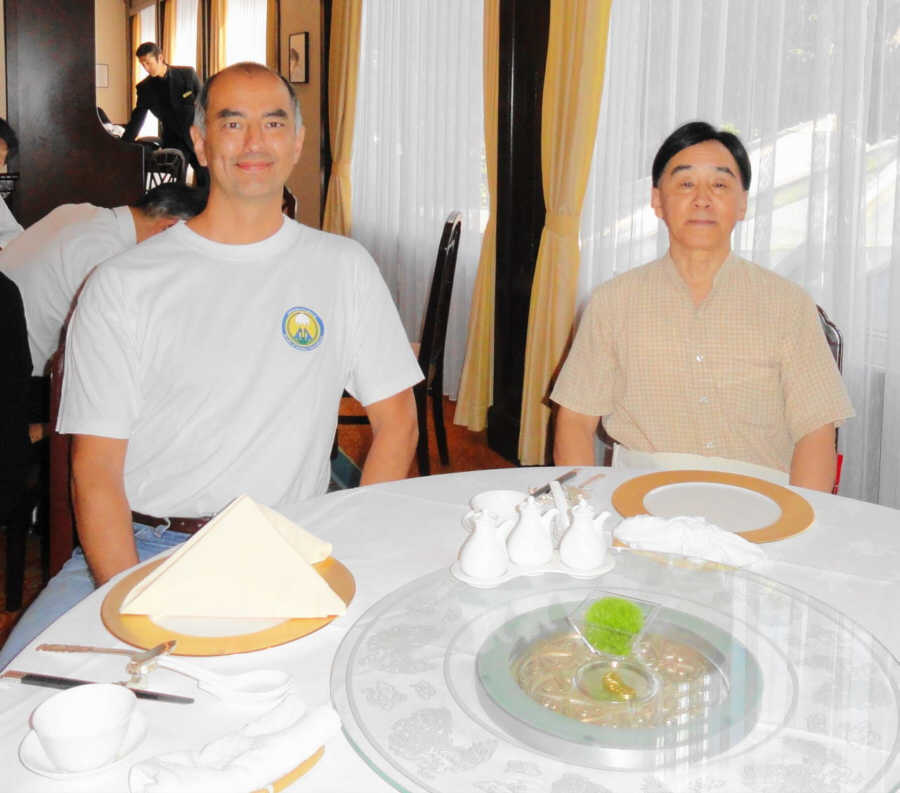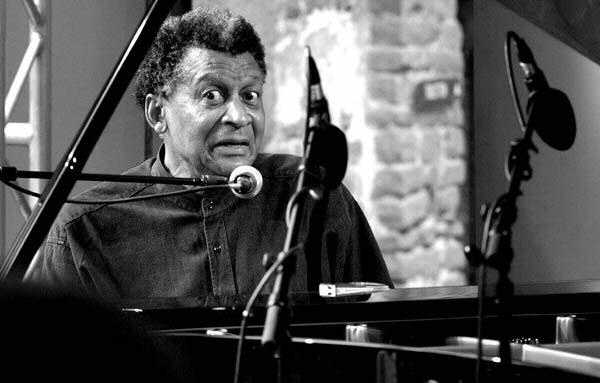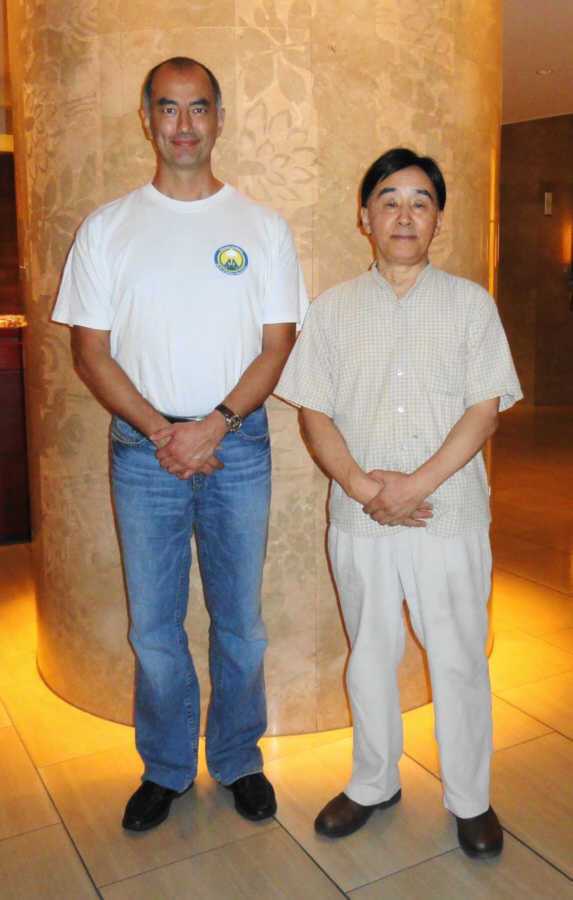
The captain of the SAS plane landed gently on the sunlit runway at Tokyo's airport, Narita International Airport. It was the 57th time I was in Japan, and this trip to Japan was also supposed to include a training camp with my grandmaster in Budo and Bujutsu; Soke Sensei Yukio Tonegawa (SST), the Supreme Grandmaster of Jokokan International and Bujutsu Kodosokukai.
I was very much looking forward to this 42nd Japan training camp with SST and the martial arts laboratory.

The following week, Abdullah Ibrahim (Dollarbrand, 77 years old), the head of Jokokan USA & South Africa, was going to a training camp with SST in Yari, Bo and Enshin Hsingi. Dollarbrand is Gokui Menkyo Kaiden and has been training with SST since 1967 in the old Budokan, Amagertorv, Copenhagen. Unfortunately we couldn't get it to work together, but at least we could communicate via email and phone as we saw fit.
Besides being a world famous jazz pianist, ANC and lifelong friend of Nelson Mandela, Dollarbrand is very popular in Japan. There had just been a 1½-hour portrait broadcast of him on Japanese television NHK, and he was one of the main guests at the South African embassy's official reception and party for the celebration of 100 years between South Africa and Japan at government level. A reception and party SST is also invited to.
As a prelude to the training camp, I visited Japan's former capital, Kamakura, where Japan's first shogun, Minamoto no Yoritomo (1147-1199), had established his government after the Gempei War (1180-1185) with the Taira clan.
The trip to Kamakura, however, was more purposeful as then, when I, together with tens of thousands of other people, visited the temple of the god of war; Tsurugaoka Hachiman-gū from 1063, which is Kamakura's most important Shinto temple, although it has existed the longest as a Buddhist temple.
The temple is both a Unesco world heritage, and therefore also a very important cultural focal point for both the area, but also Japan. The temple is probably most famous for its annual three-day early medieval festival, where there are various martial arts displays, ending with Yabusame (archery from galloping horse).
Yabusame has two main schools (ryu). Takeda-ryu, which has over 1,000 years behind it and Ogasawara-ryu, which is more than 800 years old. Ogasawara-ryu Honbu (main school) has a residence in the temple, where both Kyudo (Archery) and Yabusame (archery from a horse) are practiced.
This has continued to the now 31´th grand champion in a straight line. The Ogasawara family is of the Seiwa Genji (Minamoto) lineage, and related to the temple's founder, Japan's first Shogun, Minamoto no Yoritomo, - who was, incidentally, a cousin of the ancestor of the Yamana family in a straight line. So it all ties together.
It was a wonderful prelude to a wonderful and life-affirming training camp in the martial arts laboratory.
SST was a bit tired after TV recordings and newspaper interviews the day before, and just had to have a cup of green tea from the morning before we could get started.
SST will be 73 in a few months. But when he's in the dojo performing his martial arts, it's like seeing a 30-year-old young man. Except a 30-year-old will never be able to do martial arts at SST's level. It was an incredibly intense training camp, interrupted only by short pee and food breaks.
The idea behind the martial arts laboratory is still the action that no knowledge and experience should be lost if this can be avoided through transfer. Imagine if all the knowledge and experience in the entire history of humanity was passed down from generation to generation. This would truly be an optimal situation where the "Wheel and the Deep Dish" was not invented again and again, but further developed for the benefit of the future generations who are able to handle and understand this knowledge and experience.
In Budo and Bujutsu, this requires a certain insight and understanding, which the martial art has chosen to define through the old densho (full martial art degrees) and newer dan (specialized martial art degrees). In the martial arts laboratory, only the old denshograds count, which are universal, and not tied to a special system, since all real martial art systems at a higher level are based on the same forces and principles, where politics, money, status and ego are delightfully liberating and totally irrelevant.
The single contribution that made the biggest impression on me was Arakawa Busen's original Sanchin kata. The only kata he practiced every day, as an incarnated Zen Buddhist. Sanchin I had not trained for the last 15-20 years, but I gained a whole new view and respect for this kata. The correct Sanchin must last 3.5 minutes, which in isolation and logically is a very long time for such a short kata. To get the essence of Arakawa Busen throughout a lifetime is to get the essence of all his teachers throughout their lives, which is to get the essence of karate throughout its history.
I should probably explain this in more detail. Arakawa Busen Sensei, is 85 years old, 10th dan, Goju-ryu Karate-do and at the same time Soke for Sokan-ryu Kobudo (Preservation of Okinawa Kobudo). He has had a string of Okinawa Karate-do legendary grandmasters; Shinkawa Sensei, 10th dan, Goju-ryu, Ichikawa Sensei (1924-2005) 10th dan Goju-ryu, Taira Shinken (1897-1970), 10th dan Goju-ryu & Shito-ryu, as well as their teachers Izumigawa Sensei ( 1908-1969),, 10.dan, Yabiku Moden Sensei (1882-1941), founder of Yamane-ryu Kobudo, and the cultural organization "Ryukyu Kobujutsu Kenkyo Kai". Seko Higa Sensei (1898-1966), 10.dan Goju-ryu Karate-do, Gichin Funakoshi Sensei (1868-1957), founder of Shotokan Karate-do, Kenwa Mabuni (1889-1952), founder of Shito-ryu Karate -do, Anko Itosu (1831-1915), founder of Shorin-ryu Karate-do, Chojun Miyagi Sensei (1888-1953), founder of Goju-ryu Karate-do, Kanryo Higashioanna Sensei (1853-1916), Sokon Matsumura ( 1809-1901), founder of the Shuri-te Karate form, Kanga Sakugawa (1733-1815), who has been called the "father of Okinawa karate". One of his teachers was Kusanku. As well as many others, since at that time the focus was mostly on who you could learn from in order to improve your Budo and yourself. Unfortunately, that is not the case today.
The relationship between SST and Arakawa Busen Sensei goes back more than 40 years. SST has cultivated Goju-ryu himself in his search for the perfect system. Via this entrance, he was invited by Arakawa Busen to also study original Okinawa Kobudo in the late 60s. In 1974 he was 5th dan in Sokan-ryu specializing in Nunchaku, Tonfa, Sai, Jo and Bo (Which I was taught in the period from 1988 to 1992. However, I must admit that it never really caught my interest when the sword had won my heart from the beginning of).
Through the Japanese but worldwide Budo & Bujutsu magazine, HIDEN, the connection was re-established again in 2009. Arakawa Busen had read some articles by SST, and via HIDEN Magazine, for which they both wrote feature articles, the contact was re-established. Since then, an exchange has taken place where the Arakawa Bus has transferred all its essence to the SST, and vice versa. SST even for fun brought out his old sai to show his old Kobudo master that he hadn't completely forgotten, and even though there had been more than a doubling of dan since 1974.

I feel incredibly privileged and humbled to be "served" the essence, knowledge and experience of several generations of Budo grandmasters, handed down from generation to generation. At times I can almost feel and see them during the training, and while reading about them. My respect for the real and old Budo and Bujutsu grandmasters has always been high, grateful and respectful, but as SST also says, I wouldn't be in the situation I'm in if I wasn't good enough and was the as I am. Yes, that's true enough, but as by far the youngest member (45 years old) of men who are the same age or older than my father, I think it's a different situation outside the dojo, and I'm fine here I'm allowed to have the great respect for the heritage and history of these grandmasters. However, this does not apply within the dojo, where only the skills count.
When I think about my 42 twentieth training camp in Japan these days, I can't help but say to myself; "However, it was a splendid, life-affirming and meaningful experience and learning".






